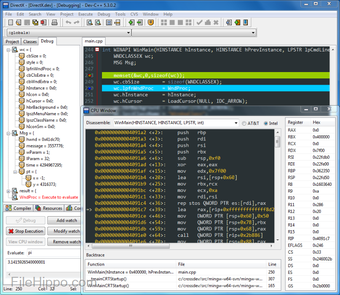Codigos De Lenguaje Dev C++
- Introducci´on al lenguaje de programaci´on C 1.1. Lenguaje C C es un lenguaje de programaci´on,creado a mediados de 1980 por Bjarne Strousstrup, como extensio´n del lenguaje C. Este lenguaje abarca tres paradigmas de la programaci´on: 1. Programacion Estructurada 2. Programacion Gen´erica 3. Programacion Orientada a Objetos En la.
- The precision modifier has different meanings depending on the format command being used: With%e,%E, and%f, the precision modifier lets you specify the number of decimal places desired.For example,%12.6f will display a floating number at least 12 digits wide, with six decimal places. With%g and%G, the precision modifier determines the maximum number of significant.
Las familias de funciones ? printf y ? scanf de entrada/salida en C++ soportan una cadena de texto conteniendo códigos y banderas de formato para indicar diferentes tipos y opciones de formato y justificación.
» MENU CON ALGUNAS FUNCIONES DE LISTAS SIMPLEMENTE ENLAZADAS, DOBLEMENTE ENLAZADAS Y CIRCULARES ENLAZADAS. Mar Jul 10, 2012 1:03 pm por javierthno ».Curso Completo de C. Mar Mar 06, 2012 11:31 pm por lorddelioncourt » de teocomp sin espacios- hay muchas formas de mejorarlo y corregirlo.
| Código | Formato |
|---|---|
| %c | un char (caracter) |
| %d | un entero con signo en notación de base decimal |
| %i | un entero con signo |
| %e | reales((pseudoreales como double)) en notación científica indicando el exponente con 'e' |
| %E | reales((pseudoreales como double)) en notación científica indicando el exponente con 'E' |
| %f | formato de punto flotante |
| %g | la opción más corta entre '%e' y '%f' |
| %G | la opción más corta entre '%E' y '%F' |
| %o | un entero sin signo en notación de base octal |
| %s | una cadena de caracteres |
| %u | un entero sin signo |
| %x | un entero sin signo en notación de base hexadecimal, usando minúsculas para los dígitos extendidos |
| %X | un entero sin signo en notación de base hexadecimal, usando mayúsculas para los dígitos extendidos |
| %p | un puntero |
| %n | un puntero a un entero en el cual se deposita la cantidad de caracteres escritos hasta el momento |
|
[editar]Modificadores de Formato
Algunos de los códigos superiores pueden aceptar caracteres modificadores de formato para ajustar aún mejor la entrada o salida de datos de maneras específicas:
[editar]Ancho Mínimo
An integer placed between a % sign and the format command acts as a minimumfield width specifier, and pads the output with spaces or zeros to make it longenough. If you want to pad with zeros, place a zero before the minimum fieldwidth specifier:
You may also specify the minimum field width in an int variable if instead of anumber you put the * sign:
[editar]Precisión
You can also include a precision modifier, in the form of a .N where N is somenumber, before the format command:
The precision modifier has different meanings depending on the format commandbeing used:
- With %e, %E, and %f, the precision modifier lets you specify the number of decimal places desired. For example, %12.6f will display a floating number at least 12 digits wide, with six decimal places.
- With %g and %G, the precision modifier determines the maximum number of significant digits displayed.
- With %s, the precision modifier simply acts as a maximum field length, to complement the minimum field length that precedes the period.
C++ Lenguaje De Programacion
As with field width specifier, you may use an int variable to specify the precision modifier by using the * sign:
Lenguaje C Pdf
[editar]Justificación
All of printf's output is right-justified, unless you place a minus signright after the % sign. For example,
will display a floating point number with a minimum of 12 characters, 4 decimalplaces, and left justified.
[editar]Tipos de Datos asociados
You may modify the %d, %i, %o, %u, and %x typespecifiers with the letter l and the letter h to specify long and short datatypes (e.g. %hd means a short integer).
The %e, %f, and %g type specifiers can have the letter l before them to indicate that a double follows. The %g, %f, and %e type specifiers can be preceded with the character # to ensure thatthe decimal point will be present, even if there are no decimal digits.
[editar]Base de numeración
The use of the # character with the %x type specifier indicates that the hexidecimalnumber should be printed with the 0x prefix.
The use of the # characterwith the %o type specifier indicates that the octal value should be displayedwith a 0 prefix.
[editar]Signo
Inserting a plus sign + into the type specifier will force positive values tobe preceded by a + sign. Putting a space character ' ' there will forcepositive values to be preceded by a single space character.
- ---
You can also include constant escape sequences in the output string.
